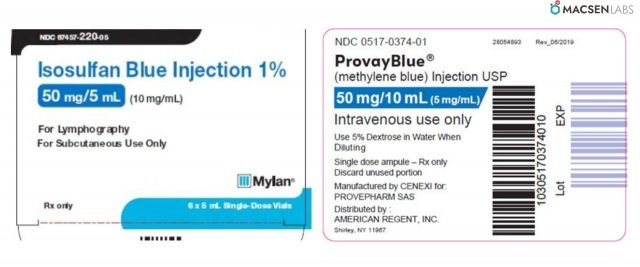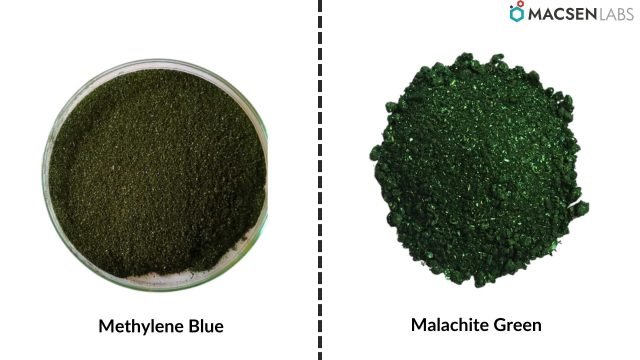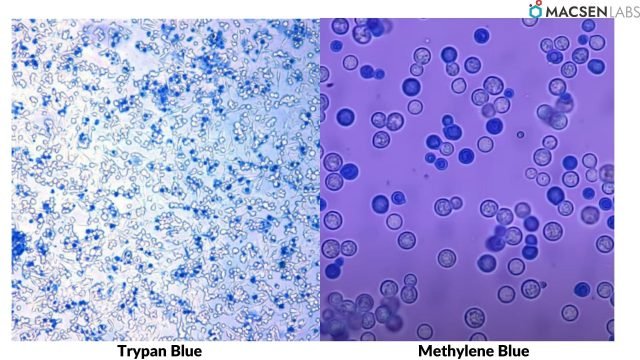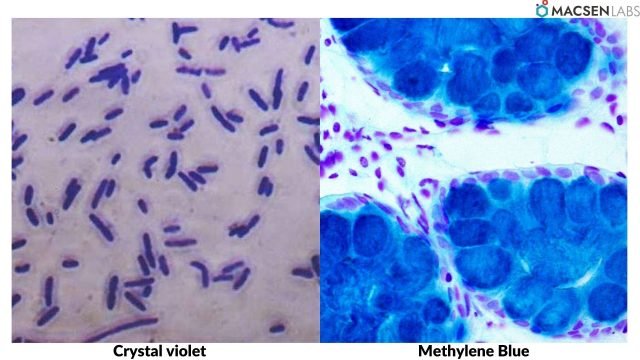Home » Blog » Pharmaceutical Dyes »
Pharmaceutical Dyes hold a huge significance in the Pharma industry. Even though there are several combinations available for the purpose, some of the combinations work better than others. It is pertinent to understand them in detail before opting for one.
Table of Contents
Isosulfan Blue vs Methylene Blue

Methylene blue works by transforming haemoglobin’s ferric iron into ferrous iron. It is a thiazine dye and is mainly used in the treatment of methemoglobinemia, a blood disease. Isosulfan blue is a blue dye that is used in lymphography to see how well the lymphatic system is performing in different places of the body. It works by staining the lymph nodes and veins in the body.
Methylene blue dye is substantially less expensive than Isosulfan blue, doesn’t produce hypersensitivity responses or other serious consequences, and, most importantly, is as excellent as Isosulfan blue when it comes to SLN mapping.
Experiments and research have been conducted to see the comparisons between Methylene Blue and Isosulfan Blue. In an article published on jamanetwork.com with the title ‘Occurrence of Prolonged Injection Site Mass With Methylene Blue but Not Isosulfan Blue After the Sentinel Node Procedure’ on February 21, 2011, it was concluded that Methylene blue provides a number of benefits, including low cost, no allergic responses, and no interference in pulse oximetry. So, from a cost point of view, Methylene Blue is preferred over Isosulfan Blue.
Malachite Green vs Methylene Blue
Methylene Blue is used to treat fungal and bacterial diseases, whereas Malachite Green is used to treat parasitic infections.
Malachite green is a bright green dye that is often used to cure a wide range of ailments in both freshwater and marine animals. It’s also used as a dye for cloth, leather and paper. Formalin is frequently combined with malachite green. The mixture is a potent treatment that may be used to treat a variety of infections resulting from parasites. Malachite green is thought to function by acting as a metabolic toxin.
Methylene Blue is commonly used as a Redox indicator. When subjected to an oxidising environment, the solutions are blue, but when introduced to a reducing agent, they become colourless. Because Methylene blue is a redox dye that increases cellular oxygen uptake, the hydrogen oxidised is carried on to the oxygen.
About 100 times every second, each colour molecule is oxidised and reduced. Methylene blue is effective against methemoglobin poisoning as well as disinfection. Methylene blue’s antibacterial and parasitic activity is most likely related to its ability to attach to cytoplasmic components within the cell, as well as its involvement with oxidation-reduction reactions.

Methyl Blue vs Methylene Blue
Methyl Blue also known as Cotton Blue or Ink Blue, is a chemical compound with the molecular formula C37H27N3Na2O9S3. It is an acid triphenylmethane dye and is used as a stain for histologic studies by staining collagen blue in tissue sections. It can also be used in some differential staining techniques such as Mann’s eosin-methyl blue method, Mallory’s connective tissue stain and Gömöri trichrome stain. It is also used to mediate electron transfer in microbial fuel cells. Fungal cell walls are also stained by methyl blue.
Methylene Blue on the other hand is a basic thiazine dye and is much more useful scientifically. As an acidic solution, it colours nucleic acids and acidic carbohydrates. At neutral or alkaline pH it colours everything. Methylene blue is used in conjunction with eosin and other dyes in stains for blood cells and parasites, and it is also extensively used in bacteriology.
Indigo Carmine vs Methylene Blue

Indigo Carmine is formed via aromatic sulfonation of indigo and is an organic salt, which makes the chemical water-soluble. Intravenous injections of indigo carmine are commonly used in urologic operations to illuminate sections of the urinary system. The dye is swiftly taken off from the blood by the kidneys, turning the urine blue. This allows surgeons to observe the architecture of the urinary system in the operating room and determine if there is a leak.
The use of dyes during colonoscopy aids in the detection of mucosal anomalies. Indigo Carmine and Methylene blue are two dyes that have gained popularity. When excited by the white light, Methylene Blue, unlike Indigo Carmine, is taken up by the cells and causes cellular DNA damage in vitro by generating singlet oxygen. Indigo carmine, on the other hand, seems to be photo-stable and has limited ability to harm genetic codes in vitro. The degree of DNA damage (especially oxidative DNA damage) in oesophageal cells is enhanced following Methylene Blue, according to a recent clinical investigation.
Patent Blue vs Methylene Blue
Patent Blue is an aniline dye used commonly. Patent blue was developed by Guerbet and approved by Health Canada on December 31, 1979. It is used for marking lymphatic vessels and arterial territories as well as for sentinel lymph nodes prior to biopsy in patients with operable breast cancer and clinically negative lymph nodes in combination with a radiotracer. Patent blue is also used in the textile, paper, agriculture and cosmetic industry.
Both Patent Blue and Methylene Blue are used as diagnostic agents for the detection of the sentinel lymph node in breast cancer patients. But in contrast to Patent Blue, Methylene Blue is more widely available and much more cost-effective. Also, Patent Blue poses a greater risk of anaphylaxis and hypersensitivity reactions, thus methylene blue is the preferred choice of agent.
Trypan Blue vs Methylene Blue

Trypan Blue is a cotton textile direct dye. It is used as a crucial stain in biosciences to particularly stain dead cells blue. Trypan blue is an azo dye that is often used in microscopy (to count cells) and in lab experiments to determine tissue viability, however, is unable to tell the difference between necrotic and apoptotic cells.
Fungal hyphae and stramenopiles can be observed with it. In ocular cataract surgery, it is used to stain the anterior capsule to help in visualising before performing the continual curvilinear capsulorhexis. Both Methylene Blue and Trypan Blue are viability stains.
Methylene Blue has been used to test yeast viability in beer, wine, and other alcoholic beverages. Non-viable cells are stained blue, but viable (alive) yeast do not acquire stain and remain colourless.
Animal cells are stained with Trypan blue, which produces the same findings as Methylene Blue. Trypan blue is not acquired, or we can say it is rejected, in a live cell because live cells have an intact cell membrane, trypan blue cannot penetrate the cell membrane of live cells and enter the cytoplasm. This is why it is frequently referred to as a dye exclusion technique. The dye, on the other hand, penetrates through dead cells due to their porous cell membrane and shows blue colour when observed under a microscope.
Acriflavine vs Methylene Blue

Acriflavine is a fluorescence labelling agent used in biochemistry for RNA that has a high molecular weight. It’s used as an antifungal to treat aquarium fishes.
Acriflavine is an antiseptic that is applied to the skin. It’s a powder that’s orange or brown in colour. It’s a dye that stains and irritates the skin. The hydrochloride version irritates more than the neutral version. HIF-1, which stops blood vessels from developing to supply tumours with blood and interferes with glucose intake and usage, has been demonstrated to be inhibited by acriflavine in a study.
Acriflavine, which can cure plasmids harbouring genes that are resistant to antibiotics from Gram-positive bacteria, may be beneficial in battling the common cold virus. It may also help in the battle against antibiotic-resistant bacteria.
Acriflavine can be used to treat fungal infections in fishes, but Methylene Blue is still preferred over Acriflavine.
Methylene blue may be used safely to scan precancerous lesions in vivo, according to an article published on bmcpulmmed.biomedcentral.com on March 31, 2015. The use of acriflavine in people is not supported by this research.
Crystal Violet vs Methylene Blue

Crystal Violet (Gentian Violet) is employed as a histology stain and in Gram’s technique of bacterial classification. Crystal violet was once used as a topical antiseptic because of its antimicrobial, antifungal, and antiparasitic qualities. Methylene blue is occasionally used instead of crystal violet, and it works just as well.
Another prominent application of Crystal Violet is in the textile industry, paper industry and as a component for printing inks for pens and printers.
Disclaimer-
The information provided here is based on general knowledge, articles, research publications etc and we do not claim the authenticity of any of the information provided above. We do not claim or suggest/advise any medical, therapeutic, health or nutritional benefits of our Pharmaceutical Dyes. We do not supply or promote our Pharmaceutical Dyes for the applications which are covered by valid patents and which are not approved by the FDA.
Macsen Labs is a manufacturer and supplier of several grades of pharmaceutical dyes:- Speciality Dyes and Biological Stains

